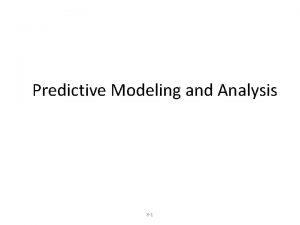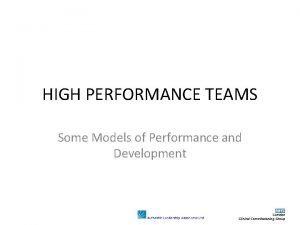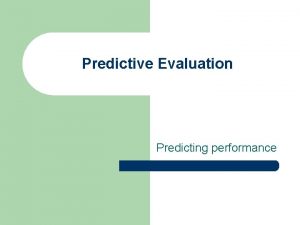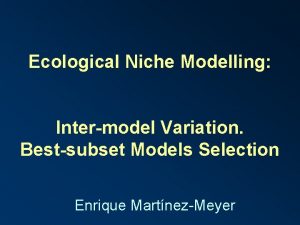Testing Predictive Performance of Ecological Niche Models A



























- Slides: 27

Testing Predictive Performance of Ecological Niche Models A. Townsend Peterson, STOLEN FROM Richard Pearson

Niche Model Validation • Diverse challenges … – Not a single loss function or optimality criterion – Different uses demand different criteria – In particular, relative weights applied to omission and commission errors in evaluating models • Nakamura: “which way is relevant to adopt is not a mathematical question, but rather a question for the user” – Asymmetric loss functions


Where do I get testing data? ?

Model calibration and evaluation strategies: resubstitution Projection Calibration All available data Same region Different region 100% Different time Different resolution Evaluation (after Araújo et al. 2005 Gl. Ch. Biol. )

Model calibration and evaluation strategies: independent validation Projection Same region All available data 100% Different region Calibration Evaluation Different time Different resolution (after Araújo et al. 2005 Gl. Ch. Biol. )

Model calibration and evaluation strategies: data splitting Projection Calibration data Calibration 70% Same region Different time Test data 30% Different resolution Evaluation (after Araújo et al. 2005 Gl. Ch. Biol. )

Types of Error

The four types of results that are possible when testing a distribution model (see Pearson NCEP module 2007)

Presence-absence confusion matrix Recorded present Recorded (or assumed) absent Predicted present a (true positive) b (false positive) Predicted absent c (false negative) d (true negative)

Thresholding


Selecting a decision threshold (p/a data) (Liu et al. 2005 Ecography 29: 385 -393)

Selecting a decision threshold (p/a data)

Selecting a decision threshold (p/a data) Omission (c/a+c) (proportion of presences predicted absent) Commission (b/b+d) (proportion of absences predicted present)

Selecting a decision threshold (p-o data) T 10 LPT

Threshold-dependent Tests (= loss functions)

The four types of results that are possible when testing a distribution model (see Pearson NCEP module 2007)

Presence-absence test statistics Recorded present Recorded (or assumed) absent Predicted present a (true positive) b (false positive) Predicted absent c (false negative) d (true negative) Proportion (%) correctly predicted (or ‘accuracy’, or ‘correct classification rate’): (a + d)/(a + b + c + d)

Presence-absence test statistics Recorded present Recorded (or assumed) absent Predicted present a (true positive) b (false positive) Predicted absent c (false negative) d (true negative) Cohen’s Kappa:

Presence-only test statistics Recorded present Recorded (or assumed) absent Predicted present a (true positive) b (false positive) Predicted absent c (false negative) d (true negative) Proportion of observed presences correctly predicted (or ‘sensitivity’, or ‘true positive fraction’): a/(a + c)

Presence-only test statistics Recorded present Recorded (or assumed) absent Predicted present a (true positive) b (false positive) Predicted absent c (false negative) d (true negative) Proportion of observed presences correctly predicted (or ‘sensitivity’, or ‘true positive fraction’): a/(a + c) Proportion of observed presences incorrectly predicted (or ‘omission rate’, or ‘false negative fraction’): c/(a + c)

Presence-only test statistics: testing for statistical significance U. sikorae Success rate: 4 from 7 Proportion predicted present: 0. 231 Binomial p = 0. 0546 U. sikorae Success rate: 6 from 7 Proportion predicted present: 0. 339 Binomial p = 0. 008 Leaf-tailed gecko (Uroplatus)

Absence-only test statistics Recorded present Recorded (or assumed) absent Predicted present a (true positive) b (false positive) Predicted absent c (false negative) d (true negative) Proportion of observed (or assumed) absences correctly predicted (or ‘specificity’, or ‘true negative fraction’): d/(b + d)

Absence-only test statistics Recorded present Recorded (or assumed) absent Predicted present a (true positive) b (false positive) Predicted absent c (false negative) d (true negative) Proportion of observed (or assumed) absences correctly predicted (or ‘specificity’, or ‘true negative fraction’): d/(b + d) Proportion of observed (or assumed) absences incorrectly predicted (or ‘commission rate’, or ‘false positive fraction’): b/(b + d)

AUC: a threshold-independent test statistic (1 – omission rate) (fraction of absences predicted present) Recorded present Predicted absent Recorded (or assumed) absent a (true positive) b (false positive) c (false negative) d (true negative) sensitivity = a/(a+c) specificity = d/(b+d)

Threshold-independent assessment: The Receiver Operating Characteristic (ROC) Curve A B set of ‘absences’ Frequency 1 set of ‘presences’ sensitivity 0 Predicted probability of occurrence 1 C set of ‘presences’ Frequency set of ‘absences’ 0 0 1 - specificity 1 0 Predicted probability of occurrence 1 (check out: http: //www. anaesthetist. com/mnm/stats/roc/Findex. htm)
 Can a realized niche be larger than a fundamental niche
Can a realized niche be larger than a fundamental niche Niche partitioning
Niche partitioning The lion's ecological niche includes its behavior and
The lion's ecological niche includes its behavior and What is an ecological niche? *
What is an ecological niche? * What is a niche in biology
What is a niche in biology Niche definition
Niche definition Niche simple
Niche simple Logic driven model
Logic driven model Ecological performance standards
Ecological performance standards Semi-modals
Semi-modals Team performance models
Team performance models What is domain
What is domain Kv charts in software testing
Kv charts in software testing Data flow testing strategies in software testing
Data flow testing strategies in software testing Positive testing vs negative testing
Positive testing vs negative testing Static testing and dynamic testing
Static testing and dynamic testing Anuj magazine
Anuj magazine Functional testing vs unit testing
Functional testing vs unit testing Language testing
Language testing Control structure testing in software testing
Control structure testing in software testing Decision table testing in software testing
Decision table testing in software testing Decision table for triangle problem
Decision table for triangle problem Pengertian pengujian black box
Pengertian pengujian black box Behavior testing adalah
Behavior testing adalah Table based testing
Table based testing Rigorous testing in software testing
Rigorous testing in software testing Testing blindness in software testing
Testing blindness in software testing Component testing is a black box testing
Component testing is a black box testing

















































